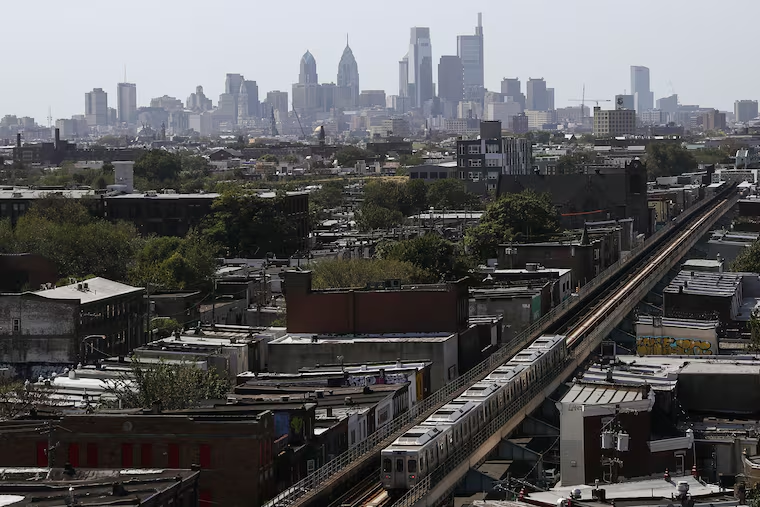The Market-Frankford Line is SEPTA’s workhorse. A ‘dramatic change’ to service starts soon.
The changes go into effect Monday to coincide with new spring schedules beginning Sunday, including the elimination of skip-stop service and greater frequency into the evening.

Call it the Market-Frankford Line, MFL, the blue line, or the El — to SEPTA, it’s the workhorse.
The Market-Frankford Line is SEPTA’s busiest line, with about 180,500 passengers every weekday — and rising, as Philadelphia’s population continues to grow and a construction boom has yet to slow.
Changes to accommodate growing ridership on weekdays go into effect Monday to coincide with new spring schedules going into use Sunday, including the elimination of skip-stop service and greater frequency later into the evening. The adjustments come as SEPTA has plans for other improvements, and while it continues to work on a long-term engineering fix for a problem that surfaced three years ago.
“I stress often to my own team that the Market-Frankford Line is an extreme priority — it is SEPTA," said Scott Sauer, assistant general manager of operations. "There is no SEPTA without the Market-Frankford Line.”
‘Dramatic change’
Riders will no longer have to peer to see if there’s a "A" or "B" train coming to take them where they need to go. Trains now will make all stops.
After two pilot programs, SEPTA is ending its A/B skip-stop service, a longstanding feature intended to better distribute riders around rush hour — not to act like an express train. The skip-stop service’s end impacts eight stations, mostly concentrated on the east end of the line, at the Berks, York-Dauphin, Huntingdon, Somerset, Tioga, and Church stations, as well as Millbourne and 63rd Street on the west end.
SEPTA has slowly stopped skipping stations as ridership has increased dramatically over the last two decades. At Berks, weekday ridership soared 174% between 1996 and 2016, and 133% at Church during that time. Tioga and Huntingdon saw similar figures.
“It’s really a dramatic change to the service that we’re providing on the Market-Frankford Line, in order to try to meet increased demand," he said of Monday’s changes.
Trains also will run more frequently later into the weekday evenings as more people are leaving their jobs well after 5 p.m. From 6 until 7 p.m., riders should expect a train every six instead of every 10 minutes, and a train every eight minutes from 7 until 8 p.m.
SEPTA won’t need any additional cars or staffing as the adjustments begin, Sauer said.
Fixing defects
SEPTA is still repairing cracks it identified in its M4 cars in 2017, causing the agency to pull some of the fleet from service, making for crowded trains and requiring supplemental bus service. It’s working on all 218 cars in the fleet, while it relies on about 138 to run during those peak hours.
“Once we got the service level back, there was still — there may have been the impression that it was over with, but we were still continuing work on the long-term fix," SEPTA spokesperson Andrew Busch said.
Permanent repairs costing between $15 million and $18 million over the next few years should add an additional three decades of life to the cars but leave the agency with little wiggle room as it takes them out of service, both to repair the cracks and for normal maintenance, as reported by PlanPhilly this month.
“It’s just taken us this long to kind of go through car by car, make temporary fixes," Sauer said. “We’ve built our own facility now, so we could perform these permanent repairs that we had the space to kind of dedicate to the fleet.”
But the process has spurred calls from transit advocates for greater transparency, a call also heard as the historic Route 15 trolley cars were recently taken out of service and replaced by buses for at least a year.
Sauer said he believes the agency has been forthcoming in regard to the M4 repairs.
“I would simply say that this is not the first time we’ve talked about it, that we were completely transparent when the issue came to light," he said.
Planned improvements
SEPTA also is rearranging seats to give more riders a place to stand when cars become crowded. Nearly 20% of the fleet is completed, and the rest is scheduled over the next four years as part of its normal vehicle overhaul process, Busch said.
What about countdown clocks on the Market-Frankford Line, like the ones in Washington or London, that show arrival times? SEPTA had hoped to test the feature last year.
“It’s certainly something that we can do. We just have to have the investment," he said.
SEPTA has ambitions to make room for its growing number of El riders with longer platforms that could fit an eight-car train set instead of its normal six. But the projected price tag is $1.3 billion.
“It is something that’s still on our radar, and still something we want to fund,” Sauer said.